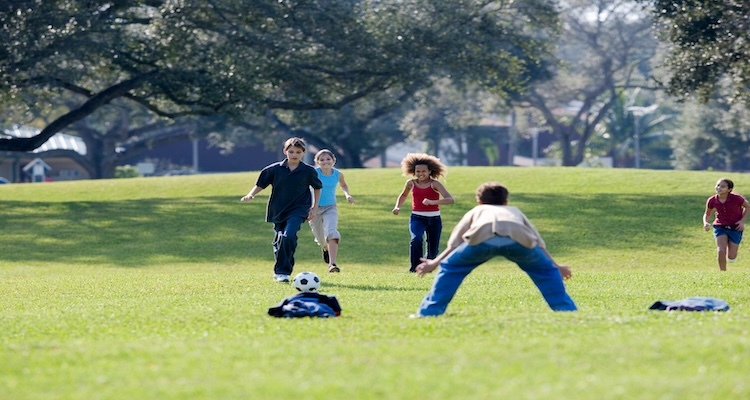
In today's digital age, getting kids off their screens and into physical activities can be a challenge. However, the benefits of engaging in sports and games are undeniable. From improving physical fitness to fostering social skills and boosting self-esteem, these activities play a crucial role in a child's development.
Let’s explore a variety of exciting sports activities and games that will not only keep kids active but also entertained. We'll dive into team sports, individual activities, and even some creative twists on classic games. Whether you're a parent, teacher, or caregiver, you'll find plenty of ideas to get kids moving, laughing, and learning valuable life skills.
Team sports are an excellent way for kids to develop social skills, learn to work together, and understand the value of cooperation. Here are some popular team sports that kids of all ages can enjoy:
Known as the world's most popular sport, soccer is accessible and requires minimal equipment. It improves cardiovascular fitness, coordination, and teamwork skills.
This fast-paced sport enhances hand-eye coordination, agility, and strategic thinking. It's also great for improving cardiovascular health.
A low-impact sport that's excellent for building upper body strength, improving reflexes, and fostering communication among team members.
This non-contact sport combines elements of football, soccer, and basketball. It's a fantastic way to improve endurance, agility, and hand-eye coordination.
A safer alternative to tackle football, this sport teaches strategy, teamwork, and agility without the risk of heavy contact.
Rotating Positions: Encourage kids to try different positions in team sports. This helps them develop a well-rounded skill set and understand the game from various perspectives.
When organizing team sports, it's essential to have the right equipment and ensure a safe playing environment. Many parents find that having extra large face wipes on hand is useful for quick clean-ups after intense play sessions, especially on hot days or muddy fields.
Outdoor play equipment can significantly enhance a child's physical activity levels and provide endless opportunities for fun and exercise. One particularly versatile piece of equipment is the swing set. Swing sets offer more than just swinging—they can be the centerpiece of a backyard playground and the starting point for numerous games and activities.
If you're considering adding a swing set to your backyard, you might want to explore DIY swing set plans. Building your own swing set can be a rewarding project that allows you to customize the design to fit your space and your children's preferences. Plus, it can be a great bonding activity for the whole family.
Here are some creative ways to use a swing set for engaging activities:
Set up plastic bottles as pins and use the swing to knock them down.
Incorporate the swing set into a more extensive obstacle course, using the swings, slide, and climbing elements.
Use the structure as a stage for puppet shows or dramatic play.
Hang targets at different heights and distances from the swings for kids to aim at with soft balls.
Versatile Play Equipment: Investing in versatile play equipment like a swing set provides children with countless opportunities for physical activity and creative play. It encourages outdoor time and can adapt to children's changing interests as they grow.
While team sports are great for meeting physical activity recommendations and fantastic for developing social skills, individual sports offer their own unique benefits. These activities help kids build self-confidence, learn self-discipline, and develop a strong sense of personal responsibility. Here are some engaging individual sports for kids:
An excellent full-body workout that improves cardiovascular health, muscle strength, and flexibility. It's also a valuable life skill.
This sport enhances flexibility, balance, and body awareness. It's great for building strength and courage.
Activities like karate, taekwondo, or judo teach self-defense, discipline, and respect while improving physical fitness.
With various events like running, jumping, and throwing, track and field offers something for every child and helps develop speed, strength, and endurance.
This sport improves hand-eye coordination, agility, and strategic thinking. It's also a great way to burn energy and stay active.
Outdoor Adventure: Consider introducing kids to outdoor adventure sports like rock climbing or hiking. These activities provide physical benefits, foster a connection with nature, and build resilience.
Sometimes, the most engaging activities for kids are those that combine physical activity with creativity and imagination. Here are some fun ideas that will get kids moving without feeling like they're exercising:
Set up a backyard obstacle course using household items. This activity improves agility, problem-solving skills, and creativity.
Put on some music and have a dance-off. Dancing is a great cardiovascular workout and helps improve coordination and rhythm.
Create an active scavenger hunt that requires kids to run, jump, or climb to find hidden objects.
Beyond just spinning the hoop, create games like hula hoop tag or relay races.
Use balloons instead of a regular volleyball for a slower-paced, more accessible version of the game.
While introducing kids to various sports and activities is important, encouraging consistent participation is key to reaping the full benefits. Here are some strategies to keep kids engaged:
Engaging kids in sports activities and games is not just about keeping them physically active—it's about nurturing their overall development, building lifelong healthy habits, and creating joyful memories. There's a world of options to explore, from team sports that foster cooperation to individual activities that build self-reliance and creative games that spark imagination.
Remember, the key is to make physical activity fun and accessible. The possibilities are endless, whether it's organizing a neighborhood soccer game, building a DIY swing set, or creating a backyard obstacle course. By encouraging regular physical activity, we're not just helping kids stay fit; we're equipping them with valuable life skills, boosting their confidence, and setting them up for a healthier, happier future.
This is a Sponsored Post
